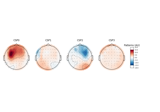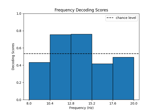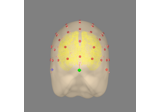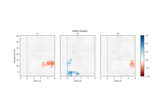mne.datasets.eegbci.load_data#
- mne.datasets.eegbci.load_data(subject, runs, path=None, force_update=False, update_path=None, base_url='https://physionet.org/files/eegmmidb/1.0.0/', verbose=None)[source]#
Get paths to local copies of EEGBCI dataset files.
This will fetch data for the EEGBCI dataset 1, which is also available at PhysioNet 2.
- Parameters
- subject
int The subject to use. Can be in the range of 1-109 (inclusive).
- runs
int|listofint The runs to use. See Notes for details.
- path
None|str Location of where to look for the EEGBCI data storing location. If None, the environment variable or config parameter
MNE_DATASETS_EEGBCI_PATHis used. If it doesn’t exist, the “~/mne_data” directory is used. If the EEGBCI dataset is not found under the given path, the data will be automatically downloaded to the specified folder.- force_updatebool
Force update of the dataset even if a local copy exists.
- update_pathbool |
None If True, set the MNE_DATASETS_EEGBCI_PATH in mne-python config to the given path. If None, the user is prompted.
- base_url
str The URL root for the data.
- verbosebool |
str|int|None Control verbosity of the logging output. If
None, use the default verbosity level. See the logging documentation andmne.verbose()for details. Should only be passed as a keyword argument.
- subject
- Returns
- paths
list List of local data paths of the given type.
- paths
Notes
The run numbers correspond to:
run
task
1
Baseline, eyes open
2
Baseline, eyes closed
3, 7, 11
Motor execution: left vs right hand
4, 8, 12
Motor imagery: left vs right hand
5, 9, 13
Motor execution: hands vs feet
6, 10, 14
Motor imagery: hands vs feet
For example, one could do:
>>> from mne.datasets import eegbci >>> eegbci.load_data(1, [4, 10, 14], os.getenv('HOME') + '/datasets')
This would download runs 4, 10, and 14 (hand/foot motor imagery) runs from subject 1 in the EEGBCI dataset to the ‘datasets’ folder, and prompt the user to save the ‘datasets’ path to the mne-python config, if it isn’t there already.
References
- 1
Gerwin Schalk, Dennis J. McFarland, Thilo Hinterberger, Niels Birbaumer, and Jonathan R. Wolpaw. BCI2000: a general-purpose brain-computer interface (BCI) system. IEEE Transactions on Biomedical Engineering, 51(6):1034–1043, 2004. doi:10.1109/TBME.2004.827072.
- 2
Ary L. Goldberger, Luis A. N. Amaral, Leon Glass, Jeffrey M. Hausdorff, Plamen Ch. Ivanov, Roger G. Mark, Joseph E. Mietus, George B. Moody, Chung-Kang Peng, and H. Eugene Stanley. PhysioBank, PhysioToolkit, and PhysioNet: Components of a new research resource for complex physiologic signals. Circulation, 2000. doi:10.1161/01.CIR.101.23.e215.
Examples using mne.datasets.eegbci.load_data#

Motor imagery decoding from EEG data using the Common Spatial Pattern (CSP)

Decoding in time-frequency space using Common Spatial Patterns (CSP)


